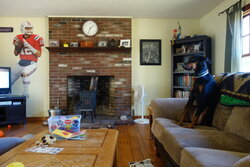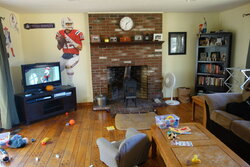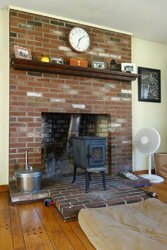Howdy! I am the new owner of a used jotul 602 and I love this thing. The previous owner had it in a small 10x16 cabin for two years so it was gently used ( until now :-/ ). I have a Newmac combination wood/oil furnace in the basement and picked up this Jotul 602 to use during the shoulder seasons before the wood furnace gets running so I don't burn much oil. I also picked the 602 because is fit in my existing hearth with no mods and because I wanted something just to have fires in the living room on cold nights. My living room also has a ton of glass so it is a tad drafty. So far as a shoulder season stove and as a purely aesthetic addition to my living room I am loving it.
One thing that is for sure is that this little thing is a blast furnace. It can and will get up to high temps fast. I have checked for leaks and all seems well. The stove is airtight except for around the cook plate and at the flue. My question is about max temps and more specifically where to measure temps. I have it setup for rear exit so I can measure temps on top of the cover plate for the top exit. I have accidentally hit 900 degrees on the center of the cook plate but it was only about 700 on the rest of the top including on the rear exit cover plate. I know that is pushing it and it was an accident. I have also broke 800 on the cook plate a few times now. Is the cook plate designed to be hotter than the rest and does that make it a bad place to measure temps? The previous owner had the cook plate upside down and I have left it that way. Is that bad? Where should I measure temps on this thing? I have an ir thermometer. What is a good max temp for the cook plate and what is a good max temp on the top flue exit cover? I have not measured a flue temp over 500, even when the stove was over 800 on the cook plate. I have run the cook plate for a couple of hours at 750 a couple times. Is that really bad? The rest of the top was around 650 and the flue was down around 400. I think my flue connections are leaky which is keeping the temps down on it but I have tons of draft. I have about an 18 foot chimney which is a 6 inch liner inside of a masonry chimney with about 5 foot of flex pipe to get me through the fireplace opening and around the stubborn rusty latch/hinges. I have been burning oak, beech, maple and black birch for the most part.
I appreciate any help you guys can give me. The owners manual says nothing about max temps or where to measure them. Also, here is a pic of my setup. The chimney liner is in the chimney straight but the flex pipe does snake it's way through the fireplace opening. I need to just take an angle grinder to the latch and hinges from the old fireplace baffle. They are in the way. I will still need the oval pipe to get through but if I cut those off at least I will be able to run it straighter.


One thing that is for sure is that this little thing is a blast furnace. It can and will get up to high temps fast. I have checked for leaks and all seems well. The stove is airtight except for around the cook plate and at the flue. My question is about max temps and more specifically where to measure temps. I have it setup for rear exit so I can measure temps on top of the cover plate for the top exit. I have accidentally hit 900 degrees on the center of the cook plate but it was only about 700 on the rest of the top including on the rear exit cover plate. I know that is pushing it and it was an accident. I have also broke 800 on the cook plate a few times now. Is the cook plate designed to be hotter than the rest and does that make it a bad place to measure temps? The previous owner had the cook plate upside down and I have left it that way. Is that bad? Where should I measure temps on this thing? I have an ir thermometer. What is a good max temp for the cook plate and what is a good max temp on the top flue exit cover? I have not measured a flue temp over 500, even when the stove was over 800 on the cook plate. I have run the cook plate for a couple of hours at 750 a couple times. Is that really bad? The rest of the top was around 650 and the flue was down around 400. I think my flue connections are leaky which is keeping the temps down on it but I have tons of draft. I have about an 18 foot chimney which is a 6 inch liner inside of a masonry chimney with about 5 foot of flex pipe to get me through the fireplace opening and around the stubborn rusty latch/hinges. I have been burning oak, beech, maple and black birch for the most part.
I appreciate any help you guys can give me. The owners manual says nothing about max temps or where to measure them. Also, here is a pic of my setup. The chimney liner is in the chimney straight but the flex pipe does snake it's way through the fireplace opening. I need to just take an angle grinder to the latch and hinges from the old fireplace baffle. They are in the way. I will still need the oval pipe to get through but if I cut those off at least I will be able to run it straighter.


Attachments
Last edited by a moderator:





